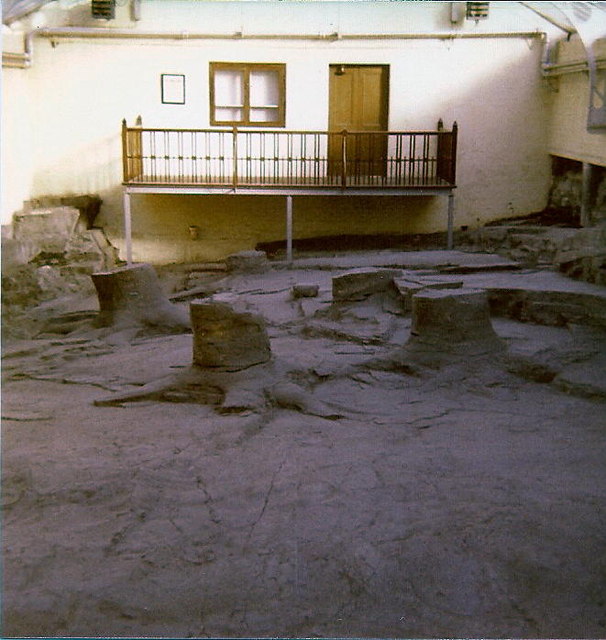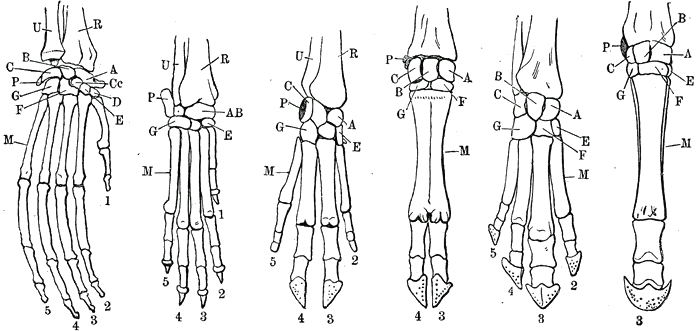|
Pampadromaeus Barberenai
''Pampadromaeus'' is an extinct genus of basal sauropodomorph dinosaurs known from the Late Triassic ( Carnian) Santa Maria Formation of the Paraná Basin in Rio Grande do Sul, southern Brazil.Cabreira et al., 2011 Discovery ''Pampadromaeus'' is known only from the holotype specimen ULBRA-PVT016, a disarticulated, partial but well preserved skeleton from a single individual which includes most of the skull bones and the lower jaws; dorsal, sacral and caudal vertebrae; elements of the shoulder girdle and the forelimbs, an ilium and elements of the hindlimbs. It was collected in the upper ''Hyperodapedon'' biozone from the Alemoa Member of the Santa Maria Formation ( Rosário do Sul Group) in the "Janner" (also known as "Várzea do Agudo") locality, geopark of Paleorrota, dating to the Carnian faunal stage of the early Late Triassic, about 230–228 million years ago. A U-Pb (uranium decay) dating found that the Santa Maria Formation dated around 233.23 million ye ... [...More Info...] [...Related Items...] OR: [Wikipedia] [Google] [Baidu] |
Late Triassic
The Late Triassic is the third and final epoch (geology), epoch of the Triassic geologic time scale, Period in the geologic time scale, spanning the time between annum, Ma and Ma (million years ago). It is preceded by the Middle Triassic Epoch and followed by the Early Jurassic Epoch. The corresponding series (stratigraphy), series of rock beds is known as the Upper Triassic. The Late Triassic is divided into the Carnian, Norian and Rhaetian Geologic time scale, Ages. Many of the first dinosaurs evolved during the Late Triassic, including ''Plateosaurus'', ''Coelophysis'', and ''Eoraptor''. The Triassic–Jurassic extinction event began during this epoch and is one of the five major mass extinction events of the Earth. Etymology The Triassic was named in 1834 by Friedrich August von Namoh, Friedrich von Alberti, after a succession of three distinct rock layers (Greek meaning 'triad') that are widespread in southern Germany: the lower Buntsandstein (colourful sandstone'')'', t ... [...More Info...] [...Related Items...] OR: [Wikipedia] [Google] [Baidu] |
Lower Jaw
In anatomy, the mandible, lower jaw or jawbone is the largest, strongest and lowest bone in the human facial skeleton. It forms the lower jaw and holds the lower teeth in place. The mandible sits beneath the maxilla. It is the only movable bone of the skull (discounting the ossicles of the middle ear). It is connected to the temporal bones by the temporomandibular joints. The bone is formed prenatal development, in the fetus from a fusion of the left and right mandibular prominences, and the point where these sides join, the mandibular symphysis, is still visible as a faint ridge in the midline. Like other symphyses in the body, this is a midline articulation where the bones are joined by fibrocartilage, but this articulation fuses together in early childhood.Illustrated Anatomy of the Head and Neck, Fehrenbach and Herring, Elsevier, 2012, p. 59 The word "mandible" derives from the Latin word ''mandibula'', "jawbone" (literally "one used for chewing"), from ''wikt:mandere, man ... [...More Info...] [...Related Items...] OR: [Wikipedia] [Google] [Baidu] |
Million Years Ago
The abbreviation Myr, "million years", is a unit of a quantity of (i.e. ) years, or 31.556926 teraseconds. Usage Myr (million years) is in common use in fields such as Earth science and cosmology. Myr is also used with Mya (million years ago). Together they make a reference system, one to a quantity, the other to a particular place in a year numbering system that is ''time before the present''. Myr is deprecated in geology, but in astronomy ''Myr'' is standard. Where "myr" ''is'' seen in geology it is usually "Myr" (a unit of mega-years). In astronomy it is usually "Myr" (Million years). Debate In geology a debate remains open concerning the use of ''Myr'' (duration) plus ''Ma'' (million years ago) versus using only the term ''Ma''. In either case the term '' Ma'' is used in geology literature conforming to ISO 31-1 (now ISO 80000-3) and NIST 811 recommended practices. Traditional style geology literature is written The "ago" is implied, so that any such year number "X M ... [...More Info...] [...Related Items...] OR: [Wikipedia] [Google] [Baidu] |
Faunal Stage
In chronostratigraphy, a stage is a succession of rock strata laid down in a single age on the geologic timescale, which usually represents millions of years of deposition. A given stage of rock and the corresponding age of time will by convention have the same name, and the same boundaries. Rock series are divided into stages, just as geological epochs are divided into ages. Stages can be divided into smaller stratigraphic units called chronozones. (See chart at right for full terminology hierarchy.) Stages may also be divided into substages or indeed grouped as superstages. The term faunal stage is sometimes used, referring to the fact that the same fauna (animals) are found throughout the layer (by definition). Definition Stages are primarily defined by a consistent set of fossils (biostratigraphy) or a consistent magnetic polarity (see paleomagnetism) in the rock. Usually one or more index fossils that are common, found worldwide, easily recognized, and limited to a s ... [...More Info...] [...Related Items...] OR: [Wikipedia] [Google] [Baidu] |
Geopark
A geopark is a protected area with internationally significant geology within which sustainable development is sought and which includes tourism, conservation, education and research concerning not just geology but other relevant sciences. In 2005, a European Geopark was defined as being: "a territory with a particular geological heritage and with a sustainable territorial development....the ultimate aim of a European Geopark is to bring enhanced employment opportunities for the people who live there." Today the geopark is virtually synonymous with the UNESCO geopark, which is defined and managed under the voluntary authority of UNESCO's International Geoscience and Geoparks Programme (IGGP). UNESCO provides a standard for geoparks and a certification service to parks that apply for it. The service is available to member states of UNESCO. This list is not the same as the member states of the United Nations. Membership in the UN does not automatically imply membership in UNESCO, ... [...More Info...] [...Related Items...] OR: [Wikipedia] [Google] [Baidu] |
Hyperodapedon
''Hyperodapedon'' is a genus of rhynchosaurs (beaked, archosaur-like reptiles) from the Late Triassic period (Carnian stage). Fossils of the genus have been found in Africa, Asia, Europe and North and South America. Its first discovery and naming was found by Thomas Henry Huxley in 1859. ''Hyperodapedon'' was a herbivore that used its beaked premaxilla and hindlimbs to dig for plants in dry land. Description ''Hyperodapedon'' was a heavily built, stocky, animal. ''H. gordoni'' had total length around with skull length of to , but largest species, ''H. huxleyi'' had lower jaw about and skull length is estimated about . Apart from its beak, it had several rows of heavy teeth on each side of the upper jaw, and a single row on each side of the lower jaw, creating a powerful chopping action when it ate. It is believed to have been herbivorous, feeding mainly on seed ferns, and died out when these plants became extinct at the end of the Triassic. The diagnosis of ''Hyperodapedo ... [...More Info...] [...Related Items...] OR: [Wikipedia] [Google] [Baidu] |
Hindlimb
A hindlimb or back limb is one of the paired articulated appendages (limbs) attached on the caudal ( posterior) end of a terrestrial tetrapod vertebrate's torso.http://www.merriam-webster.com/medical/hind%20limb, Merriam Webster Dictionary-Hindlimb With reference to quadrupeds, the term hindleg or back leg is often used instead. In bipedal animals with an upright posture (e.g. humans and some primates), the term lower limb is often used. Location It is located on the limb of an animal. Hindlimbs are present in a large number of quadrupeds. Though it is a posterior limb, it can cause lameness in some animals. The way of walking through hindlimbs are called bipedalism. Benefits of hindlimbs Hindlimbs are helpful in many ways, some examples are: Frogs Frogs can easily adapt at the surroundings using hindlimbs. The main reason is it can jump high to easily escape to its predator and also to catch prey. It can perform some tricks using the hindlimbs such as the somersault a ... [...More Info...] [...Related Items...] OR: [Wikipedia] [Google] [Baidu] |
Ilium (bone)
The ilium () (plural ilia) is the uppermost and largest part of the hip bone, and appears in most vertebrates including mammals and birds, but not bony fish. All reptiles have an ilium except snakes, although some snake species have a tiny bone which is considered to be an ilium. The ilium of the human is divisible into two parts, the body and the wing; the separation is indicated on the top surface by a curved line, the arcuate line, and on the external surface by the margin of the acetabulum. The name comes from the Latin (''ile'', ''ilis''), meaning "groin" or "flank". Structure The ilium consists of the body and wing. Together with the ischium and pubis, to which the ilium is connected, these form the pelvic bone, with only a faint line indicating the place of union. The body ( la, corpus) forms less than two-fifths of the acetabulum; and also forms part of the acetabular fossa. The internal surface of the body is part of the wall of the lesser pelvis and gives or ... [...More Info...] [...Related Items...] OR: [Wikipedia] [Google] [Baidu] |
Forelimb
A forelimb or front limb is one of the paired articulated appendages (limbs) attached on the cranial (anterior) end of a terrestrial tetrapod vertebrate's torso. With reference to quadrupeds, the term foreleg or front leg is often used instead. In bipedal animals with an upright posture (e.g. humans and some primates), the term upper limb is often used. A forelimb is not to be confused with a forearm, which is a distal portion of the human upper limb between the elbow and the wrist. All vertebrate forelimbs are homologous, meaning that they all evolved from the same structures. For example, the flipper of a turtle or of a dolphin, the arm of a human, the foreleg of a horse, and the wings of both bats and birds are ultimately homologous, despite the large differences between them. Specific uses of the forelimbs may be analogous if they evolved from different sub-structures of the forelimb, such as the flippers of turtles and dolphins, and the wings of birds and bats. Evolut ... [...More Info...] [...Related Items...] OR: [Wikipedia] [Google] [Baidu] |
Shoulder Girdle
The shoulder girdle or pectoral girdle is the set of bones in the appendicular skeleton which connects to the arm on each side. In humans it consists of the clavicle and scapula; in those species with three bones in the shoulder, it consists of the clavicle, scapula, and coracoid. Some mammalian species (such as the dog and the horse) have only the scapula. The pectoral girdles are to the upper limbs as the pelvic girdle is to the lower limbs; the girdles are the parts of the appendicular skeleton that anchor the appendages to the axial skeleton. In humans, the only true anatomical joints between the shoulder girdle and the axial skeleton are the sternoclavicular joints on each side. No anatomical joint exists between each scapula and the rib cage; instead the muscular connection or physiological joint between the two permits great mobility of the shoulder girdle compared to the compact pelvic girdle; because the upper limb is not usually involved in weight bear ... [...More Info...] [...Related Items...] OR: [Wikipedia] [Google] [Baidu] |




